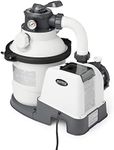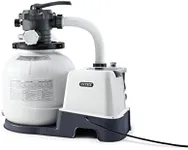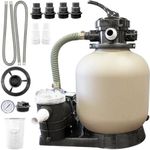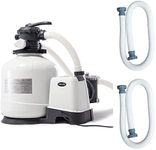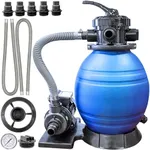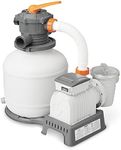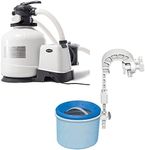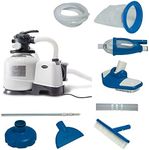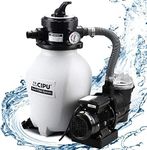Buying Guide for the Best Above Ground Pool Pumps And Sand Filters
Choosing the right above-ground pool pump and sand filter is essential for keeping your pool water clean, clear, and safe to swim in. The pump circulates the water, while the sand filter removes dirt and debris. When shopping for these, it's important to match the size and power of the pump and filter to your pool's needs, as well as consider ease of maintenance and energy efficiency. Understanding the key specifications will help you make a choice that keeps your pool in great condition with minimal hassle.Pump Flow Rate (GPH or GPM)The pump flow rate tells you how much water the pump can move, usually measured in gallons per hour (GPH) or gallons per minute (GPM). This is important because your pump needs to be strong enough to circulate all the water in your pool at least once every 8 hours. Smaller pools can use pumps with lower flow rates, while larger pools need higher flow rates. To pick the right one, calculate your pool's total water volume and make sure the pump can handle that amount within the recommended time frame. If you have a lot of swimmers or debris, a slightly higher flow rate can help keep the water cleaner.
Filter Size (Sand Capacity)The filter size, often described by how much sand it holds (in pounds), determines how much dirt and debris it can trap before needing cleaning. A larger filter can handle more debris and requires less frequent maintenance, which is helpful for bigger pools or pools in areas with lots of leaves or dust. For smaller pools or those in cleaner environments, a smaller filter may be sufficient. Match the filter size to your pool's volume and how much debris typically gets into your pool.
Pump Horsepower (HP)Pump horsepower measures the strength of the pump's motor. More horsepower means the pump can move water faster and handle larger pools or longer plumbing runs. However, too much horsepower for a small pool can waste energy and cause unnecessary wear. For most above-ground pools, a pump between 0.5 and 1.5 HP is common. Choose a horsepower that matches your pool size and the length of your pool's plumbing system—bigger pools or more complex setups may need more power.
Filter Type (Sand, Cartridge, or DE)While sand filters are most common for above-ground pools, you may also see cartridge or diatomaceous earth (DE) filters. Sand filters are easy to maintain and effective for most needs, but cartridge filters can catch finer particles and require less water for cleaning, while DE filters offer the finest filtration but need more maintenance. Consider how clean you want your water, how much time you want to spend on maintenance, and what is compatible with your pool setup.
Maintenance FeaturesLook for features that make maintenance easier, such as easy-access lids, clear pressure gauges, or multi-port valves for backwashing. These features can save you time and effort when cleaning or servicing your pump and filter. If you prefer a low-maintenance setup, prioritize models with user-friendly maintenance options.
Energy EfficiencyEnergy efficiency refers to how much electricity the pump uses to circulate your pool water. More efficient pumps can save you money on your energy bills and are better for the environment. Some pumps have variable speed settings, allowing you to run them at lower speeds for regular filtration and higher speeds for cleaning. If you want to reduce your energy use, look for pumps with energy-saving features or variable speed options.
